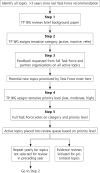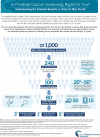Putting Evidence Into Practice: An Update on the US Preventive Services Task Force Methods for Developing Recommendations for Preventive Services
- PMID: 36973047
- PMCID: PMC10042553
- DOI: 10.1370/afm.2946
Putting Evidence Into Practice: An Update on the US Preventive Services Task Force Methods for Developing Recommendations for Preventive Services
Abstract
Purpose: The US Preventive Services Task Force (USPSTF) is an independent body that makes evidence-based recommendations regarding preventive services to improve health for people nationwide. Here, we summarize current USPSTF methods, describe how methods are evolving to address preventive health equity, and define evidence gaps for future research.
Methods: We summarize current USPSTF methods as well as ongoing methods development.
Results: The USPSTF prioritizes topics on the basis of disease burden, extent of new evidence, and whether the service can be provided in primary care and going forward will increasingly consider health equity. Analytic frameworks specify the key questions and linkages connecting the preventive service to health outcomes. Contextual questions provide information on natural history, current practice, health outcomes in high-risk groups, and health equity. The USPSTF assigns a level of certainty to the estimate of net benefit of a preventive service (high, moderate, or low). The magnitude of net benefit is also judged (substantial, moderate, small, or zero/negative). The USPSTF uses these assessments to assign a letter grade from A (recommend) to D (recommend against). I statements are issued when evidence is insufficient.
Conclusions: The USPSTF will continue to evolve its methods for simulation modeling and to use evidence to address conditions for which there are limited data for population groups who bear a disproportionate burden of disease. Additional pilot work is underway to better understand the relations of the social constructs of race, ethnicity, and gender with health outcomes to inform the development of a USPSTF health equity framework.
Keywords: clinical practice guidelines; health equity; methodology; preventive medicine.
© 2023 Annals of Family Medicine, Inc.
Figures



References
-
- US Preventive Services Task Force . Procedure Manual. https://www.uspreventiveservicestaskforce.org/uspstf/about-uspstf/method.... Accessed Nov 24, 2021.
-
- Methods Guide for Effectiveness and Comparative Effectiveness Reviews. Content last reviewed January 2020. Effective Health Care Program, Agency for Healthcare Research and Quality. https://effectivehealthcare.ahrq.gov/products/collections/cer-methods-guide. Accessed Jan 2, 2023.
MeSH terms
LinkOut - more resources
Full Text Sources
